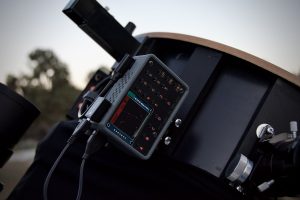A new PiFinder software update is now available with the release of update V1.9.0. The PiFinder platform is an open source, all-in-one plate solving telescope finder that can add push-to functionality to any telescope without modifications.
 As Richard Sutherland, creator of the PiFinder notes, “We’ve got a new software update (1.9.0) for the PiFinder which is available right now. We’ve been focusing this release on ‘Night Sky Serendipity’… that feeling of effortless exploration and unexpected discovery. We’re thrilled to introduce some great new features that will allow you navigate the night sky more quickly and discover new objects you may not have uncovered except for being in the right place at the right time!”
As Richard Sutherland, creator of the PiFinder notes, “We’ve got a new software update (1.9.0) for the PiFinder which is available right now. We’ve been focusing this release on ‘Night Sky Serendipity’… that feeling of effortless exploration and unexpected discovery. We’re thrilled to introduce some great new features that will allow you navigate the night sky more quickly and discover new objects you may not have uncovered except for being in the right place at the right time!”
The 4.4x3x3 inch PiFinder unit mounts into the finder shoe found on most telescopes and weighs about the same as a standard 10×50 RACI finder scope. Once mounted on a telescope it provides precision pointing information, push-to guidance, customizable star charts and even object images on the 1.5” OLED display. The display and keypad backlight are fully dimmable to preserve night vision and good relations at your favorite dark sky site.
Consisting of a Raspberry Pi, camera, OLED screen, and keypad, it can capture and solve an image of the sky each second and integrates a sophisticated accelerometer to provide real-time position and push-to guidance while moving the telescope. This plate solving + imu system removes the need for any sort of star alignment process and provides incredibly accurate positioning anywhere in the sky, making the system very beginner friendly.
The PiFinder includes a full featured catalog system with over 20,000 objects and includes images for each one. These images are presented as they would be framed and oriented through the eyepiece at their specific location in the sky. Users can filter catalogs for specific object types, by altitude, magnitude and even by previous observations. Observing lists can be built on the fly from filtered catalogs and nearby objects or loaded from a disk. As each object is observed, it can be logged directly on the PiFinder with the ability to add context about sky condition and object impression.
SkySafari and other applications that use the Meade LX protocol can connect directly to the PiFinder to view current telescope positioning with multiple updates per second. This can be done via existing Wi-Fi networks or the PiFinder can serve as a Wi-Fi access point to enable in-the-field communication.
 The PiFinder is fully open-source hardware and software package with a dedicated community of maintainers. A full parts list, build guide, and software is available for anyone interested in building a PiFinder. Kits and assembled units are also available for purchase for the less DIY minded observer.
The PiFinder is fully open-source hardware and software package with a dedicated community of maintainers. A full parts list, build guide, and software is available for anyone interested in building a PiFinder. Kits and assembled units are also available for purchase for the less DIY minded observer.
Among features of the new PiFinder software update are:
– Nearby Screen: The new ‘Nearby Screen’ offers a list of nearby celestial objects that match your current catalog filters be it globular clusters, planetary nebulae or obscure galaxies. The screen updates in real-time as you move your telescope around the sky. Set your filters and let the PiFinder guide you to new objects, complete with magnitude and essential details. It also serves as a very easy way to ID any object you have in the eyepiece as it’s sorted by closest object to more distant objects.
– Faster and more Robust Plate Solving: With this update to the star detection and solving system, enjoy reliable solving with exposures as short as 0.2 seconds under Bortle 2/3 skies – offering up to a super-fast 5 solves per second. This update promises significant improvements across all sky conditions, effortlessly dealing with obstructions like trees and buildings.
– Explore with New Catalogs: Delve deeper with the addition of the Barnard catalog of Dark Nebula and the RASC double star catalog.
You can learn more about the PiFinder software update here.
And to make it easier for you to get the most extensive news, articles and reviews that are only available in the magazine pages of Astronomy Technology Today, we are offering a 1-year magazine subscription for only $6! Or, for an even better deal, we are offering 2 years for only $9. Click here to get these deals which only will be available for a very limited time. You can also check out a free sample issue here.
The Sun is more active than it’s been in years and if that’s not enough, we have the upcoming Total Solar Eclipse on April 8, 2024! If you’d like to learn more about the technology behind solar observing, solar imaging and more, you can check out our new monthly magazine – Solar Astronomy Today. It’s free to read, no subscription needed and available here. And if you are preparing for the upcoming eclipses and want to know your equipment options from solar glasses to the most out of this world solar viewing and imaging options, check out our free publication – The Definitive Guide to Viewing and Imaging the Sun – simply click here and enjoy reading!



